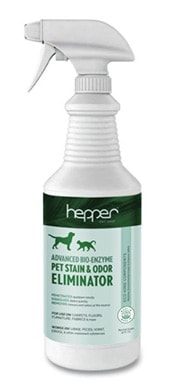How to Get Cat Vomit Smell Out of a Couch In 10 Steps (With Pictures)
-
Pete Ortiz
- Last updated:

With 58+ million cats living in US households, they’re the second most popular pets in the country. Cats are funny and a blast to play with. Plus, they are a part of the family. Now, most of us know what it’s like when a feline wets the floor or couch and how to deal with that. But what about a situation when your cat vomits on the sofa? How can you get rid of the stain and especially the awful smell?
Will you have to pay a cleaning company to get the job done? Good news: this problem can be solved with cheap, everyday products. So, in this step-by-step guide, we’ll talk about the most efficient ways of eliminating the nasty odor of cat vomit. Follow the instructions closely, and you’ll be done in no time!
What You’ll Need for the Job
If you’ve ever had the pleasure of cleaning a pet’s urine or poop, vomit won’t be that hard to handle. Moreover, the tools and products needed for this job will be almost the same. Some dish soap, vinegar, and baking soda, along with a set of towels and sponges should be enough to get you started. For a more stubborn stain (and especially smell), get some enzymatic cleaners, odor removers, and a steam cleaner. Here’s a complete list:
- Baking/Club Soda or Powder
- White, Distilled Vinegar
- Dishwashing Soap
- Enzymatic Cleaners
- Bucket Of Warm Water
- Deodorizer (To Kill The Odor)
- Dish Gloves + Plastic Bags
- Standard-Issue Spray Bottle
- Spoon For The Soda/Vinegar
- Sponges, Towels, And Cloths
- A Vacuum + Steam Cleaner
- Soft Brush For The Stains
How to Get Cat Vomit Smell Out of a Couch (10 Steps)
1. Start By Soaking It With a Towel
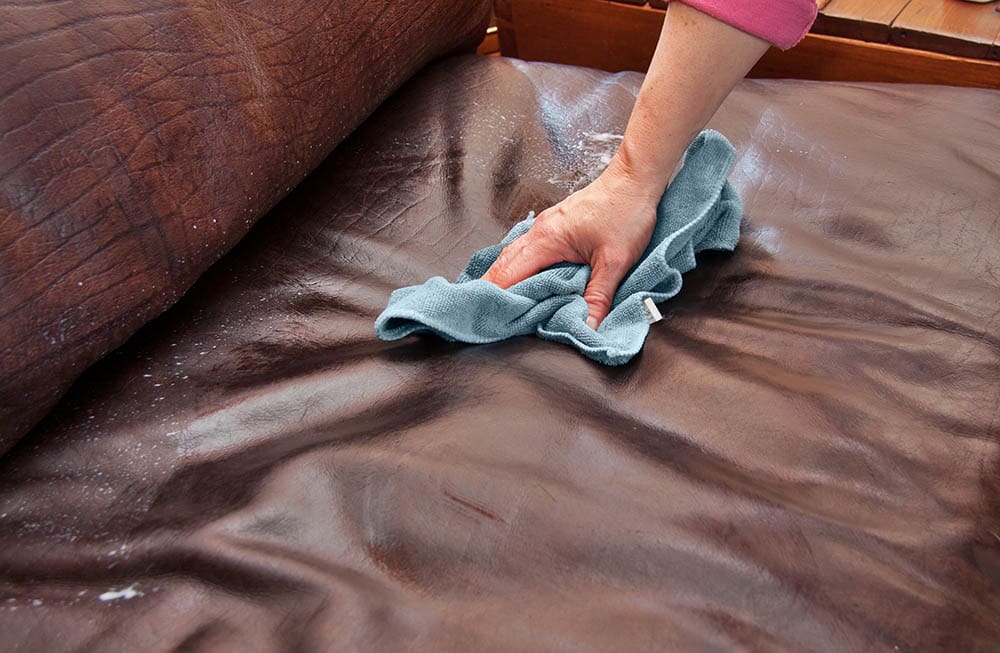
Put on a set of old dish gloves, grab a paper towel, and soak as much of the vomit as you can (sounds yuck, we know). Unless the affected area is really small, you’ll need more than one towel (rag/cloth) to handle it. Go ahead and put all used towels into plastic bags for disposal. For the most part, cat vomit is liquid and it dries up quickly.
That’s bad news because dried vomit has a really terrible odor. The reason: it soaks deeper into the couch. If you were away when the cat threw up, spray a reasonable amount of water onto the stain. This way, it will be much easier for the rags to absorb both the puke and the smell.
2. Use Baking and Club Soda
Sprinkle a liberal amount of baking soda over the mess and let it sit. On average, kitchen soda requires 2–3 hours to break down the vomit. In that time, it will kill the smell and absorb the stain from the fabric. If the pile of vomit is bigger than you expected, add more soda and give it 3–5 hours to work. Wait until the soda is dry and use a vacuum cleaner to carefully remove the residue.
Now, if the stain is still there and the smell isn’t going away, adding another layer of baking soda won’t cut it. Instead, pour some club soda over the stain. It includes extra chemicals that do a better job of breaking down pet vomit. Rinse with clean, lukewarm water and a fresh towel/rug.
Cornstarch vs. Soda: A Better Pick?
Don’t have any soda around? Then cornstarch could come in handy. First, it’s a chemical-free product and won’t cause any damage to the couch, no matter how soft it is. Second, just like soda, cornstarch absorbs and eliminates nasty odors. A common kitchen ingredient, it’s not as effective on cat vomit but will still be better than nothing. A standard pack (16 ounces) can be yours for $10–15.
3. Eliminate the Smell With Vinegar/Oil
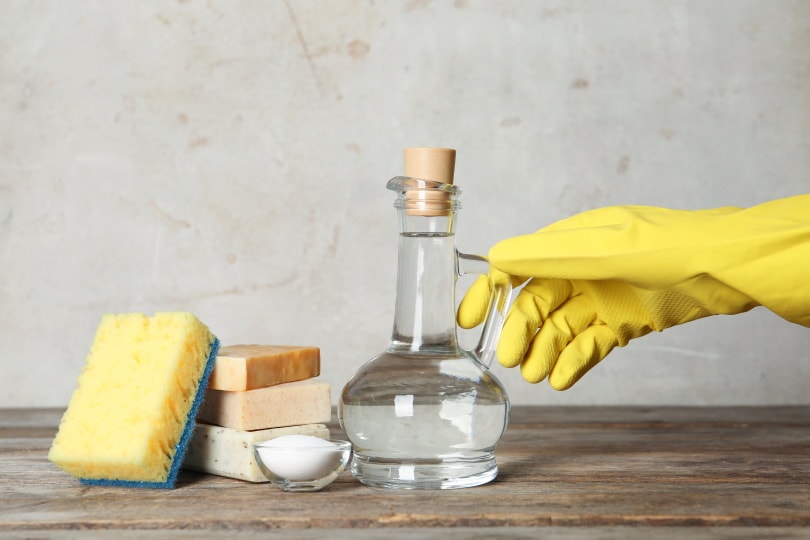
Soda is very efficient against many odors yet it’s rarely capable of removing the lingering vomit smell for good. So, what should you do? White vinegar is the answer. It’s just as cheap as baking/club soda. This natural product is incredibly strong against bile, which is known to soak deep into upholstery and ruin a couch. Mix ½ cup vinegar (white, 3%) with ½ cup water. Stir the mixture until it gets a bit foamy.
Use a tablespoon to apply the solution to the damaged area. Or, dip a sponge into it and wring/squeeze it out onto the stain. Gently rub the mixture in using a clean paper towel. A soft brush will also do. For stubborn stains, repeat the process 2–3 times. To make short work of the mess, add some soda over the vinegar. Leave the couch alone for 10–12 hours then come back later to vacuum it dry and wipe it with a towel/cloth.
4. Will Dish Soap Work, Or Not?
Yes, it will. However, dish soap is commonly known as an “assistive” solution. Therefore, go ahead and mix it with soda or vinegar (one tablespoon should be enough) and that will make the mixture more effective. On its own, dishwashing soap creates a big mess and does a rather poor job of eliminating vomit odors.
5. Don’t Forget About Hydrogen Peroxide

In many ways, peroxide is like dish soap. Its efficiency against cat vomit leaves a lot to be desired. With that said, it has a very strong enhancing effect and goes great with soda and vinegar. Hydrogen peroxide is a mild antiseptic and serves as a bleaching agent and an oxidizer. It’s mostly used against the smell of rotten food, fish, or mold, but will be useful against vomit as well.
Only add two cups of peroxide when mixing it with other cleaning products and make sure that it’s a 3% solution. You can get a 16-ounce bottle for $15–20.
6. Enzymatic Cleaners: Safe and Effective
You can’t go wrong with enzymatic cleaners. They don’t leave any residue, come in spray bottles (easy to apply) and do a stellar job of eliminating pungent odors. So, does that mean you can skip all the previous steps and solve the issue with this one product? Well, not quite. While enzymatic cleaners are, indeed, a go-to solution against smells, you still have to deal with the vomit stain(s), and that’s why we used kitchen soda, soap, and vinegar.
When choosing between different enzymatic cleaning products, pick one that’s non-toxic and safe for pets. Apply a healthy amount and let it sit for 30–60 minutes.
Are you looking for an enzyme cleaner that can keep your house clean and your pet happy? We recommend the Hepper Advanced Bio-Enzyme Pet Stain & Odor Eliminator Spray, which permanently gets rid of the most stubborn stains and smells. There’s even a 100% satisfaction guarantee so you can try this cleaner risk-free! Click here to order your first bottle.
At House Grail, we’ve admired Hepper for many years, and decided to take a controlling ownership interest so that we could benefit from the outstanding products of this cool cat company!
7. Are Stain/Odor Removers Worth It?
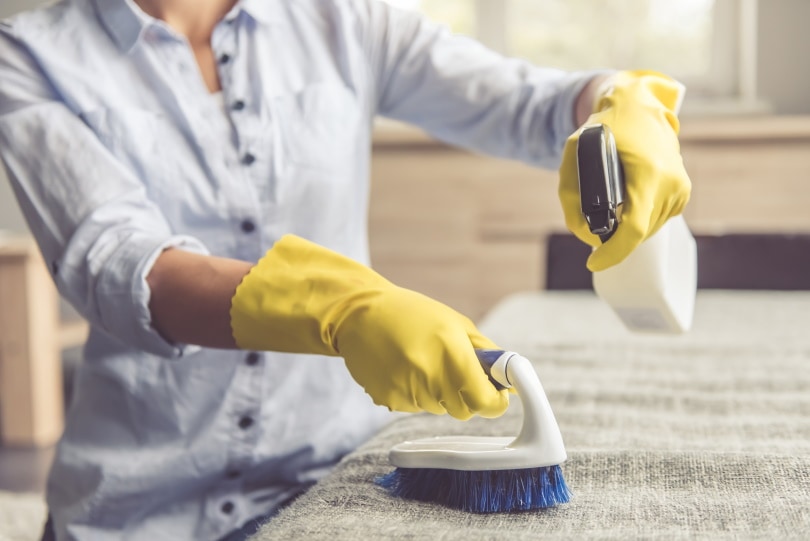
Let’s get one thing clear: there are no “magical” solutions out there. Stain removers are just a combination of carbon, potassium bicarbonate/sulfate (chemicals found in soda), surfactants, and enzymatic cleaners. So, yes, they are very well worth it, especially if you’re looking for a one-in-all type of product. Besides, these mixtures have a pleasant smell that lingers on and you can choose between spray bottles and powder.
After applying the remover to the affected area, leave it be for 10–15 minutes and then wipe it with a damp towel. Repeat the process once or twice to get rid of the vomit completely. Oh, and make sure it’s 100% safe to use on couches. Otherwise, you might end up damaging the fabric.
8. Deodorizers: Cheap and Mildly Efficient
These products do exactly what the name suggests: de-odorize the vomit (or any other mess made by your cat). And you can just pick the first product you like and spray it all over the room. Just remember that deodorizing products only mask bad odors. In contrast to vinegar, enzymatic cleaners, and soda they don’t absorb or neutralize them.
Deodorizers can still be useful, of course, especially if you don’t like the smell of vinegar.
Should You Use Coffee Grounds?
Some experts claim that coffee is the best deodorizer on the planet. Is that true? Coffee grounds do remove the smell of onions and garlic, but they’re not at all effective against cat vomit. Furthermore, they will leave an even bigger stain on the couch. You could place the grounds near the couch to freshen up the odor, but that’s it.
9. Finish the Job With a Steam Cleaner

If you have a steam cleaner, go over the couch with it once or twice to “seal the deal”. Only do this after steps 1–8, of course. The best thing about steaming—it kills germs, bacteria, and allergens. Since no couch can fit in a laundering machine, a steam cleaner is the next big thing. This is important: make sure it says “SW” (safe for steam cleaning) on the couch’s label, not “X” (not safe.)
10. What About Bleach/Other Chemicals?
Do NOT apply any bleaching products on a cat vomit stain, no matter how safe the instructions claim it is. Chemical-rich products aren’t intended for delicate upholstery on chairs or couches. Even if the smell doesn’t go away after all the products/solutions that you just used, have a professional cleaning team over instead of ruining the couch with bleach.
Why Is My Cat Vomiting? Do I Need To Worry?
Now that we know how to efficiently remove cat vomit stains (and the smell), let’s talk about what might be causing it in the first place. If this only happens once a month (or even twice a month), it’s nothing to worry about. However, if the pet throws up every week, you need to take action. Here are the most common causes and what you should do:
The Cat Is Regurgitating
Some cats are used to eating way too fast for their own digestive systems. When that happens, the kitty’s stomach regurgitates the food before it reaches the digesting stage. This is a “defensive reaction” of the cat’s body. Technically, regurgitated food isn’t actual vomit. You’ll still have to clean it up, though. If you want to prevent this from happening in the future, train the cat by giving it smaller portions.
A slow feeder bowl is also a great idea. You might have to combine these two “techniques” to achieve the desired result.
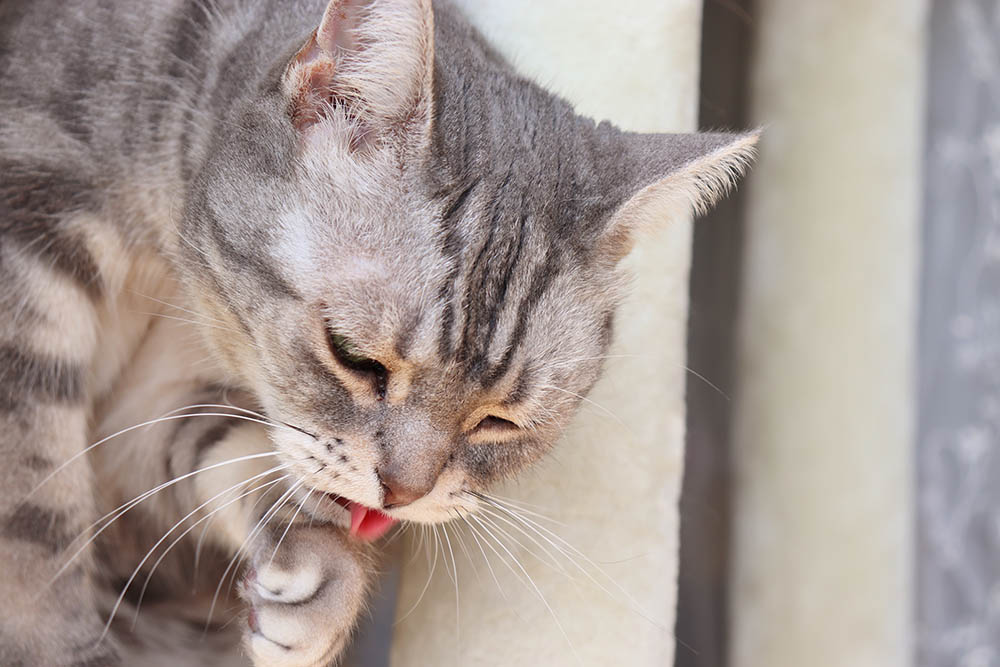
Allergies Could Be To Blame
Just like humans, cats have allergies and certain foods make them vomit. Again, it’s a natural reaction of the digestive system, nothing more. As a pet owner, you need to know which products are causing allergies in your four-legged friend. The usual suspects are fish, eggs, wheat, beef, and, of course, dairy products.
Cats are big fans of tasting table scraps, and that’s what usually makes them vomit. Having exotic food for the first time can also cause this. As for natural allergens, the list includes dust, mold, pollen, and plants. So, keep the house nice and clean, and don’t put any plants on windowsills that your cat might be allergic to.
The Pet Has Swallowed Something
As natural-born predators, cats like to play around with mice, rats, food from the bowl, and other stuff. Toys, a hairband, hairpin, coins, plastic—the list goes on. Sometimes, they swallow these items and that causes vomiting because a cat’s gastrointestinal tract can’t digest any of that. So, how can you help the poor kitty?
It’s best to get in contact with a veterinarian immediately: they’ll tell you what to do. Please, do not attempt any “rescue missions” before consulting with a vet. Oh, and if you notice your cat chewing up plastic and cardboard regularly, that’s another cause for concern. Again, a licensed vet should be able to advise you on this.
Maybe It’s A Nasty Infection?
Cats aren’t very good at expressing their pain or suffering, which leaves vomiting as one of the few easy-to-notice side effects. It could be a sign of an eating disorder or even an infection of the respiratory system, the ears, or the urogenital tract. That’s why it’s very important not to postpone a visit to a vet when the cat starts to vomit. The sooner you reach out for help, the easier it will be to get your furry buddy back on its feet!
Parasites
The vomiting hasn’t stopped yet? Then have the pet checked for parasites. Significant weight loss is a clear sign of worms living in the cat’s digestive system. Anemia is another common side effect. Good news: in most cases, no surgical procedures or even prescription medications will be necessary. A parasite cleanse should be able to help the cat. This can be a special diet or a detox product; talk to the vet.
Kidney Failure Or Pancreatitis
Last, but not least, if your cat is vomiting frequently, that could mean its kidneys are failing. Or maybe it’s suffering from pancreatitis or IBD (inflammatory bowel disease). While cleaning the vomit, see whether it includes any traces of blood. If it does, that means the health issues are very serious. Have an experienced veterinarian check the cat from head to toe. That’s the only way to find the cause and help the pet.
Conclusion
No matter how much you care for your cat, it will throw up once in a while. As we just learned, it’s the frequent vomiting that you should worry about. However, even if your feline is perfectly healthy, you still need to be ready-steady to “handle” the mess when the cat vomits on the couch. That can be done with cheap kitchen products like baking soda, vinegar, and dishwasher soap.
Couch upholstery isn’t always easy to clean, but, if you do everything right, it shouldn’t be much of a challenge to remove the aroma. Don’t make the cat feel guilty for ruining your couch (regardless of how expensive it is), make sure all the products from the list are within reach and get down to business!
Featured Image Credit: Peterpancake, Shutterstock
Contents


